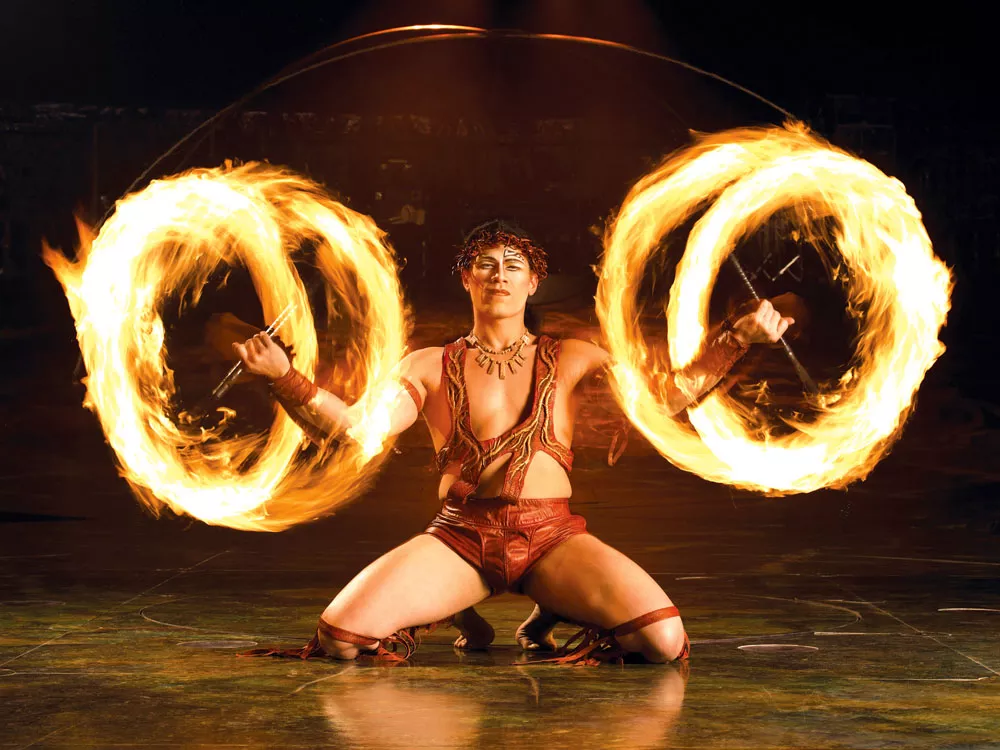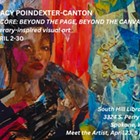A man twirls knives over his head and between his legs — and the knives are on fire.
A gymnast holds a handstand, perfectly vertical, while balancing atop a six-foot cane. The Flying Man — his face impassive, his body impossibly sculpted and graceful — uses dual bungee cords to careen up and across the stage. Acrobats attack disapproving, withered clowns.
Alegria (at the Spokane Arena, Sept. 22-26) upsets expectations at every turn. Think it’s like a traditional circus? No animals. Think it’s like theater? It has few spoken lines. Think it’s like dance? More like gymnastics raised to the level of art. Think it’s just a bunch of clowns? Alegria (“al-eh-GREE-uh”) hints at unsettling, rebellious ideas.
It isn’t simply the Spanish word for “joy.” The lyrics of the show’s title song define “alegria” as a “beautiful roaring scream/ Of joy and sorrow” that produces “a joyous, magical feeling.” In the Italian portion of its multilingual chorus, that magical feeling arrives “come un assalto di gioia” — like an assault of joy.
It’s pretty, in other words, but it’s also going to slap you upside your head.
Cirque du Soleil, which started as a troupe of street clowns in Quebec, has been around for 26 years and developed nearly that many different kinds of shows. Alegria, the troupe’s eighth production, was the first to feature a darker political theme interwoven with all the acrobatics. And Cirque has long aimed at being both pleasurable and subversive.
The artistic director of this touring arena show, Tim Smith, says that the message of Alegria concerns “the old establishment and the new generation of today — how they struggle, how they need to work together. The struggle that both groups are making is valid. But while the older generation sometimes feels the need to put constraints on freedom, the younger generation will look on things with the wide-eyed innocence of youth.”
Admittedly, the narrative in Alegria is obscure; you can ignore it and still enjoy the spectacle. Smith puts it this way: “It’s like going to a museum, and there’s a painting on the wall — I like it, you hate it. Or it evokes emotion in you — in me, nothing.”
If the show’s thematic conflict mostly has to do with aged repressiveness versus youthful freedom, then the Power Track segment — rebellious acrobats spiraling over crisscrossing runways — best evokes the show’s anger at the “makers of rules” and “breakers of backs.” These angry acrobats are known as “the Bronx,” Smith explains: “This is the part of youth that rebels. They are the ones who are fearless in going against the grain — and it’s evident in their aggressiveness.”
Youthful energy, on the other hand, comes across most clearly in the second act’s Russian Bars sequence: Picture acrobats doing synchronized somersaults after being launched off flexible poles carried on the shoulders of fellow performers — and then landing on those same bendy balance beams. (On this one, they really, really have to trust their buddies.)
Cirque du Soleil: Alegria travels in 18 trucks. Backstage operations take up half of an arena’s floor. The entire production is set to a New Age-y soundtrack (Cirque’s best-selling). Cast and crew number nearly a hundred, with 55 onstage performers; they come from 17 nations and speak a dozen languages.The performers, Smith says, “are artists — not actors, not dancers.” Many of them come from a background in gymnastics. As an example, imagine the kinds of changes faced by one of the high-bar aerialists at the end of Act One. “So you take a guy from Belarus who has normally been on the uneven parallel bars and has won medals in gymnastics, and you bring him to Montreal, and you teach him to do his act while he’s 42 feet up in the air,” Smith says. “And there’s the costume, and the makeup, and then we turn the lights off, and we train him to let go — to just jump in the dark and trust that he will be caught by two guys hanging below him in baskets.
“Now, he may be an Olympian, and experienced on the uneven bars — but when you’re 42 feet off the ground and you’re letting go, it’s a scary experience, no matter who you are.”
Alegria is more than just death-defying acrobatics, though. As Smith says, it’s “a feast for the senses that’s visually stunning.” In a show full of pretty colors, he especially favors the costumes of the Nostalgic Old Birds — striped purple leggings, bejeweled waistcoats, feathered hats, and masks that convey the bitterness of those who have seen the world pass them by. “I’ve been in theater for 15 years,” Smith says, “and I’ve never seen anything so precise or beautiful. Over the duration of Alegria’s long run, he says, “each jewel on those costumes has been in the right place for 16 years.”
But the Old Birds represent the Establishment, tyranny, repression, joylessness — which is why the Power Track Bronx-rebels leap and tumble right at the old clowns, bowling them over, gyrating in celebration of carefree abandonment.
Shrieking its defiance at repression and seeking beauty in imaginative freedom, Alegria is a beautiful scream.
Cirque du Soleil: Alegria will assault your senses on Wednesday-Saturday, Sept. 22-25, at 7:30 pm; Friday-Saturday, Sept. 24-25, at 3:30 pm; and Sunday, Sept. 26, at 1 pm and 5 pm at the Spokane Arena’s Star Theater. Tickets: $35-$94; seniors, military and students, $32-$82; youth, $28-$76. Visit http://www.ticketswest.com or call (800) 325- SEAT.

















